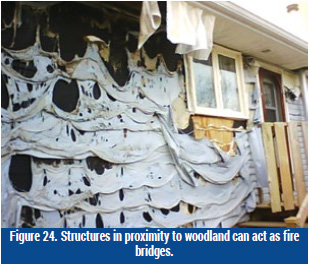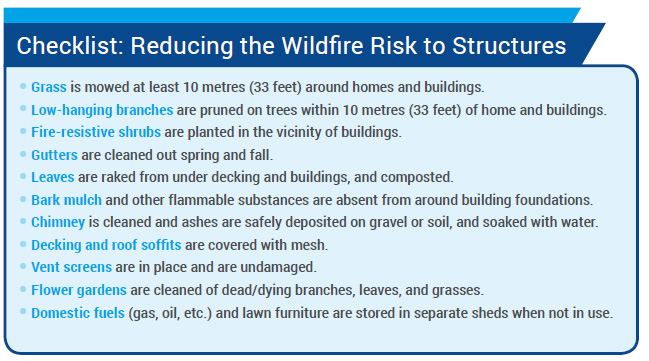Lesson 7 - Defending Your Home from Wildfire
More people than ever are living near woodland. As urban centres become decentralized and larger, more expensive dwellings are built in rural areas, people are embracing rural life. Here, however, human activity and forest dynamics collide.
Agriculture and industrial development is commonly adjacent to the forest. Many woodland owners live close to their managed woodland and may have a camp on their property. Because fires can start in structures and spread to woodland, or start in the forest and engulf buildings, you as a woodland owner should understand how to prevent and control wildfires.
|
|
Unfortunately, many people who live in rural areas are not aware of the social, environmental, and economic consequences of woodland fires. Some may not even be convinced they have responsibilities toward fie and that this burden should rest with fie departments, the Department of Natural Resources, and other agencies.
Both woodland owners and homeowners near woodland should recognize that, because of decades of effective fie suppression, fuels have accumulated in woodland areas. In the same way that reducing fuel loading in woodland can reduce the risk of wildfire, managing the availability of fuels in and around structures can also significantly lessen the chances of devastating fires.
|
|
On a larger scale, many Canadian communities have partnered with businesses and government to develop formal programs to reduce the risk of damage from wildfires.
As a homeowner who may live in a rural area, you can decrease the susceptibility of damage to your home and other structures from wildfire. Following is a checklist that you can use to be FireSmart in defending your home.
|
|
Some homeowners feel that maintaining fie-defensible areas around dwellings results in unattractive premises. This is not true. It is a fact that the landscape around your home and structures can actually be enhanced by planting fie-resistive shrubs and trees. Many of these species are visually appealing and have the added benefit o being drought-resistant. It is important to choose low-growing shrubs, which prevent the laddering of fie into tree crowns or structures. Shrubs with high water-content sap, rather than flammable resins, are also preferable. Prune and maintain your shrubs to reduce any buildup of dead wood and other flammable materials.
|
|
Be sure to talk with your neighbours about the risks of wildfire and the steps they can take to avoid catastrophe should a wildfire approach their dwellings. For more detailed information about ways to reduce the risk of wildfire damage around your home and to become FireSmart, visit www.fiesmartcanada.ca.



